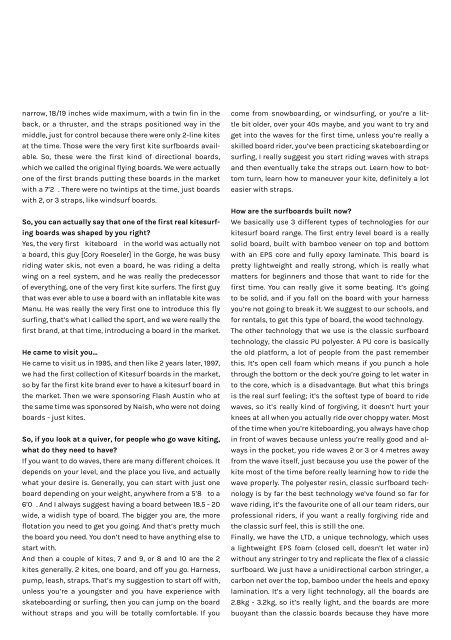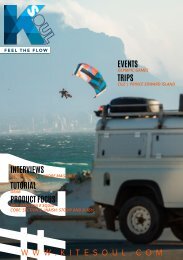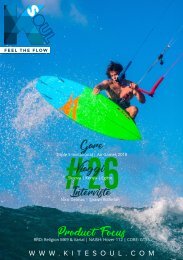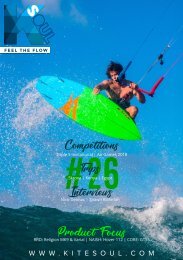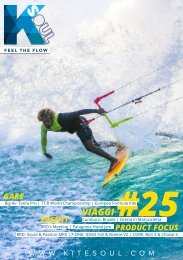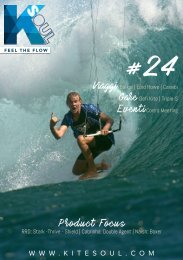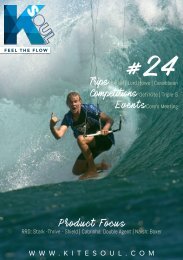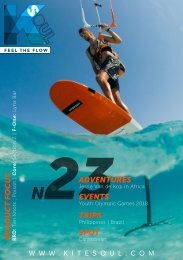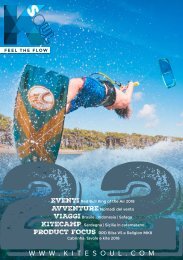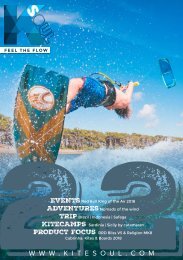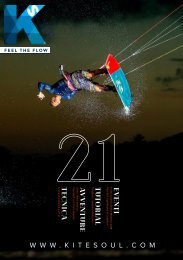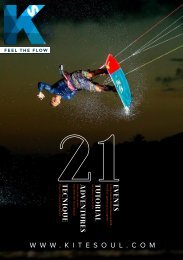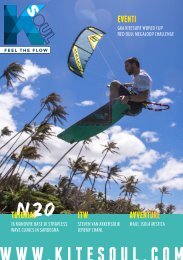Kitesoul Magazine #25 International Edition
In this issue: TwinTip Racing: Florian Gruber and Sofia Toma- soni, Airton claims his fourth win in the GKA WORLD TOUR, Jesse Richman flies higher at the inaugural Air Games event, RRD international meeting, Roberto Ricci: kitesurfing was originally about kitesurfing on waves, Guy Bridge and Daniela Moroz 2018 Formula Kite Euro champs, Patagonia Hood Jam, and much more.
In this issue: TwinTip Racing: Florian Gruber and Sofia Toma- soni, Airton claims his fourth win in the GKA WORLD TOUR, Jesse Richman flies higher at the inaugural Air Games event, RRD international meeting, Roberto Ricci: kitesurfing was originally about kitesurfing on waves, Guy Bridge and Daniela Moroz 2018 Formula Kite Euro champs, Patagonia Hood Jam, and much more.
Create successful ePaper yourself
Turn your PDF publications into a flip-book with our unique Google optimized e-Paper software.
narrow, 18/19 inches wide maximum, with a twin fin in the<br />
back, or a thruster, and the straps positioned way in the<br />
middle, just for control because there were only 2-line kites<br />
at the time. Those were the very first kite surfboards available.<br />
So, these were the first kind of directional boards,<br />
which we called the original flying boards. We were actually<br />
one of the first brands putting these boards in the market<br />
with a 7’2”. There were no twintips at the time, just boards<br />
with 2, or 3 straps, like windsurf boards.<br />
So, you can actually say that one of the first real kitesurfing<br />
boards was shaped by you right?<br />
Yes, the very first “kiteboard” in the world was actually not<br />
a board, this guy [Cory Roeseler] in the Gorge, he was busy<br />
riding water skis, not even a board, he was riding a delta<br />
wing on a reel system, and he was really the predecessor<br />
of everything, one of the very first kite surfers. The first guy<br />
that was ever able to use a board with an inflatable kite was<br />
Manu. He was really the very first one to introduce this fly<br />
surfing, that’s what I called the sport, and we were really the<br />
first brand, at that time, introducing a board in the market.<br />
He came to visit you...<br />
He came to visit us in 1995, and then like 2 years later, 1997,<br />
we had the first collection of Kitesurf boards in the market,<br />
so by far the first kite brand ever to have a kitesurf board in<br />
the market. Then we were sponsoring Flash Austin who at<br />
the same time was sponsored by Naish, who were not doing<br />
boards - just kites.<br />
So, if you look at a quiver, for people who go wave kiting,<br />
what do they need to have?<br />
If you want to do waves, there are many different choices. It<br />
depends on your level, and the place you live, and actually<br />
what your desire is. Generally, you can start with just one<br />
board depending on your weight, anywhere from a 5’8” to a<br />
6’0”. And I always suggest having a board between 18.5 - 20<br />
wide, a widish type of board. The bigger you are, the more<br />
flotation you need to get you going. And that’s pretty much<br />
the board you need. You don’t need to have anything else to<br />
start with.<br />
And then a couple of kites, 7 and 9, or 8 and 10 are the 2<br />
kites generally. 2 kites, one board, and off you go. Harness,<br />
pump, leash, straps. That’s my suggestion to start off with,<br />
unless you’re a youngster and you have experience with<br />
skateboarding or surfing, then you can jump on the board<br />
without straps and you will be totally comfortable. If you<br />
come from snowboarding, or windsurfing, or you’re a little<br />
bit older, over your 40s maybe, and you want to try and<br />
get into the waves for the first time, unless you’re really a<br />
skilled board rider, you’ve been practicing skateboarding or<br />
surfing, I really suggest you start riding waves with straps<br />
and then eventually take the straps out. Learn how to bottom<br />
turn, learn how to maneuver your kite, definitely a lot<br />
easier with straps.<br />
How are the surfboards built now?<br />
We basically use 3 different types of technologies for our<br />
kitesurf board range. The first entry level board is a really<br />
solid board, built with bamboo veneer on top and bottom<br />
with an EPS core and fully epoxy laminate. This board is<br />
pretty lightweight and really strong, which is really what<br />
matters for beginners and those that want to ride for the<br />
first time. You can really give it some beating. It’s going<br />
to be solid, and if you fall on the board with your harness<br />
you’re not going to break it. We suggest to our schools, and<br />
for rentals, to get this type of board, the wood technology.<br />
The other technology that we use is the classic surfboard<br />
technology, the classic PU polyester. A PU core is basically<br />
the old platform, a lot of people from the past remember<br />
this. It’s open cell foam which means if you punch a hole<br />
through the bottom or the deck you’re going to let water in<br />
to the core, which is a disadvantage. But what this brings<br />
is the real surf feeling; it’s the softest type of board to ride<br />
waves, so it’s really kind of forgiving, it doesn’t hurt your<br />
knees at all when you actually ride over choppy water. Most<br />
of the time when you’re kiteboarding, you always have chop<br />
in front of waves because unless you’re really good and always<br />
in the pocket, you ride waves 2 or 3 or 4 metres away<br />
from the wave itself, just because you use the power of the<br />
kite most of the time before really learning how to ride the<br />
wave properly. The polyester resin, classic surfboard technology<br />
is by far the best technology we’ve found so far for<br />
wave riding, it’s the favourite one of all our team riders, our<br />
professional riders, if you want a really forgiving ride and<br />
the classic surf feel, this is still the one.<br />
Finally, we have the LTD, a unique technology, which uses<br />
a lightweight EPS foam (closed cell, doesn’t let water in)<br />
without any stringer to try and replicate the flex of a classic<br />
surfboard. We just have a unidirectional carbon stringer, a<br />
carbon net over the top, bamboo under the heels and epoxy<br />
lamination. It’s a very light technology, all the boards are<br />
2.8kg - 3.2kg, so it’s really light, and the boards are more<br />
buoyant than the classic boards because they have more


